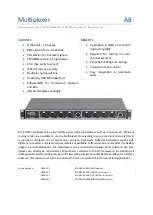
BGS technic KG
Bandwirkerstr. 3
D-42929 Wermelskirchen
Tel.: 02196 720480
Fax.: 02196 7204820
mail@bgs-technic.de
www.bgstechnic.com
© BGS technic KG, Copying and further use not allowed
WARNINGS
To avoid possible electric shock or personal injury, follow these guidelines:
1. Do not use the meter if it is damaged. Before you use the meter, inspect the case. Pay particular
attention to the insulation surrounding the connectors,
2. Inspect the test leads for damaged insulation or exposed metal. Check the test leads for
continuity. Replace damaged test leads before you use the
meter.
3. Do not use the meter if it operates abnormally. Protection may be impaired. When in doubt, have
the meter serviced.
4. Do not operate the meter around explosive gas, vapor, or dust.
5. Do not apply more than the rated voltage, as marked on the meter, between terminals or between
any terminal and earth ground.
6. Before use, verify the meters Operation by measuring a known voltage.
7. When measuring current, turn off circuit power before connecting the meter in the circuit.
Remember to place the meter in series with the circuit.
8. When servicing the meter, use only specified replacement parts.
9. Use with caution when working above 30V ac rms, 42V peak, or 60V. Such voltages pose a shock
hazard.
10. When using the probes, keep your fingers behind the finger guards on the probes.
11. Connect the common test lead before you connect the live test lead. When you disconnect test
leads, disconnect the live test lead first.
12. Remove the test leads from the meter before you open the case.
13. Do not operate the meter with the cover removed or loosened.
14. To avoid false readings, which could lead to possible electric shock or personal injury, replace the
battery as soon as the low battery indicator appears.
15. Never use the meter to measure voltages above 300V.
16. Temperature measurements should be done only on not rotating parts.
17. Remaining endangerment:
When an input terminal is connected to dangerous live potential it is to be noted that this
potential at all other terminals can occur!
18. Do
not
use the meter for measurements within Measurement Categories
CAT IV.
MEASUREMENT CATEGORIES
CAT I
Measurements on circuits that have no direct connection to the mains (battery operation),
e.g. devices of protection class 3 (operation with safety extra-low voltage), battery-
powered devices, car electrics.
CAT II
Measurements on circuits having a direct connection by means of plugs to the low-
voltage network, e.g. household appliances, portable electrical appliances.
CAT III
Measurements within the building installation (stationary consumers with non-pluggable
connection, distributor connection, permanently installed devices in the distributor), e.g.
subdistribution.
CAT IV
Measurements on sources of the low-voltage installations (meter, main connection,
primary overcurrent protection), e.g. on counters, low voltage overhead line, house
connection box.









































